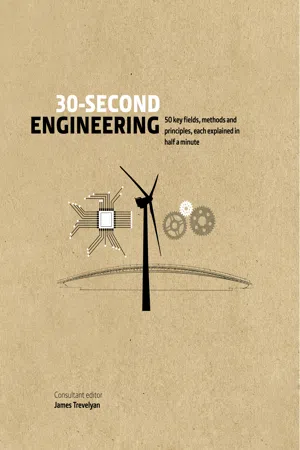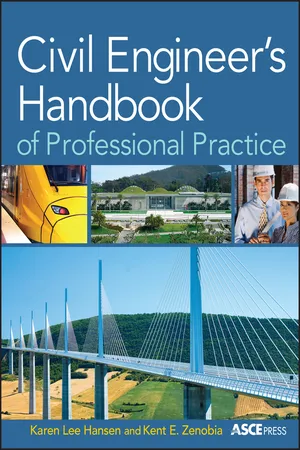Construction Engineering
Construction engineering involves the planning, design, and management of construction projects, ensuring that structures are built safely, efficiently, and within budget. It encompasses various disciplines such as civil, structural, and environmental engineering, and requires expertise in construction materials, methods, and technologies. Construction engineers play a crucial role in overseeing the construction process from inception to completion.
4 Key excerpts on "Construction Engineering"
- eBook - ePub
- P.K. Jayasree, K Balan, V Rani(Authors)
- 2021(Publication Date)
- CRC Press(Publisher)
...It also covers questions pertaining to geometrics, materials of the structural design of highways. Railway engineering : Railway engineering involves planning and construction of a surface railway, setting an alignment for the tunnels, devising the signaling systems of meeting the traffic objectives, construction of station buildings and yards. Waterways engineering : Waterways engineering deals with the transportation of people and goods in vehicles that float upon water. It deals with the construction and development of docks and harbors. Airport engineering : Airport engineering is related to constructing, developing, and maintaining various elements of airports like runways, taxiways, airport pavements, etc. Traffic engineering : Traffic engineering is that branch of engineering which deals with the initial planning, the design of geometry, and the operations of traffic related to streets, roadway and highway networks, terminals, etc., for the accomplishment of effective and convenient movement of people, as well as goods in a safe manner. It uses principles of engineering to analyze the problems of transportation by bearing in mind the psychological habits of the commuters and obtain the most optimal solution. 1.4.7 Construction Technology and Management It is very much related to environmental and structural engineering. A suitable environment is built by the construction of buildings and other structures. Codes of building bye-laws make sure of the fact that construction is good and sound. Construction Engineering thus consists of various techniques of construction for different materials adopted for various site conditions. Construction machinery, management of labor, materials, methods of construction adopted relating to the site, the fund available, all are under the purview of this discipline. The management division of this subject takes into account the managerial aspect of the construction side...
- eBook - ePub
30-Second Engineering
50 key fields, methods, and principles, each explained in half a minute
- James Trevelyan(Author)
- 2019(Publication Date)
- Ivy Press(Publisher)
...Designs evolve within regulatory, economic, structural and subsoil limitations. Construction practicalities often dictate extensive redesign, negotiation and ingenuity to preserve agreed visual appearances. Engineers provide the close supervision needed to ensure safety for everyone, and to retain sufficient alignment with design intent while accommodating the interests of everyone involved. RELATED TOPICS See also CIVIL ENGINEERING GEOTECHNICAL ENGINEERING ENVIRONMENTAL ENGINEERING 3-SECOND BIOGRAPHIES SÉBASTIEN VAUBAN 1633–1707 Responsible for defensive fortifications for several hundred French cities. OVE NYQUIST ARUP 1895–1988 Translated architect Jørn Utzon’s ideas into structures for the Sydney Opera House. SANTIAGO CALATRAVA 1951– Engineer, artist and architect: a rare combination resulting in visually stunning buildings. 30-SECOND TEXT James Trevelyan A great building is testament to a successful collaboration between engineer and architect. ENGINEERING & CIVILIZATION 30-second foundation Engineering has enabled civilization, supporting humans to move from being hunter-gatherers to being inhabitants of towns and cities, by building roads, bridges and aqueducts. Water was diverted from streams to facilitate sustainable village agriculture; systematic irrigation along the Nile enabled the prosperity of Egypt and its civil engineering legacy – pyramids and enormous temples. Similarly, Mohenjo-daro in Pakistan dates from 2500 BCE and is one of the world’s earliest major cities. Located in the Indus Valley, it drew water from groundwater wells and channelled away wastewater. It was laid out on a systematic grid like many modern cities. Roman engineers later mastered cement using volcanic ash, constructing dams, aqueducts, vast urban water supply systems and sewers, promoting vital public health for one million people...
- Karen Hansen, Kent Zenobia(Authors)
- 2011(Publication Date)
- Wiley(Publisher)
...Chapter 5 The Engineer's Role in Project Development Big Idea Civil engineers play many different roles in the project development process. Engineering problems are under-defined, there are many solutions, good, bad and indifferent. The art is to arrive at a good solution. This is a creative activity, involving imagination, intuition and deliberate choice. —Ove Arup Key Topics Covered Background Participants in the Process—The Players The Flow of Work Predesign Design Design During Bid and Construction Postconstruction Activity Summary Related Chapters in This Book Chapter 2: Background and History of the Profession Chapter 3: Ethics Chapter 4: Professional Engagement Chapter 6: What Engineers Deliver Chapter 7: Executing a Professional Commission Chapter 8: Permitting Chapter 11: Legal Aspects of Professional Practice Chapter 15: Globalization Chapter 16: Sustainability Chapter 17: Emerging Technologies Related to ASCE Body of Knowledge 2 Outcomes Background The architectural, engineering, and construction (AEC) industry always has operated on the “virtual” organization principle and is infamous for its fragmentation. Constructed products involve a staggering number of players. These include private owners, developers, government agencies, engineers and architects, other designers, builders, product and material suppliers, real estate agents, lending institutions, and inspectors among others. In the United States, where the AEC industry historically has made up 9 to 10 percent of the gross national product (GNP), the majority of firms employ fewer than 20 people. The industry is design-intensive because most projects are one-of-a-kind. Often with limited local knowledge, AEC professionals must produce unique products with stringent cost, schedule, and quality standards. Much of the design for any particular constructed product is performed by separate individuals and firms. Furthermore, project team members may not be focused on a shared goal...
- eBook - ePub
Advanced Construction Project Management
The Complexity of Megaprojects
- Christian Brockmann(Author)
- 2020(Publication Date)
- Wiley-Blackwell(Publisher)
...Often, this includes an architectural design (form and function), a civil engineering design (stability and usability), and an electrical/mechanical design (function and usability). This holds true for buildings. In civil engineering structures such as bridges, tunnels, or dams, an architectural design might be missing. There are exceptions to this rule, e.g. the Pont de Millau by Foster + Partners (Figure 8.2). Figure 8.1 Complex engineering tasks. Table 8.1 Aspects of engineering tasks and functions. Instrument Function Institution Design Calculation and drawing Designing Design department Project management Plans and meetings Managing PM office Production planning Plans and method statements Planning Engineering department Site installation Layout and logistics Planning Engineering department Construction Construction management plan Managing Site office Traditionally, architects and engineers develop the design separately, with the architect in charge of coordination. Building Information Modeling (BIM) allows all parties to work concurrently on one project model. As megaprojects tend to be singular, they must be innovative, and one part of this is design innovations. Engineers develop a design over time, and this requires design management. The process is divided into phases, and it allows for quality checks and coordination at the end of each phase. The quality checks might be internal or external with the help of independent checking engineers. Coordination also has internal and external aspects. Internally, we need to check for design clashes among architectural, civil, and E/M design. Externally, we must ensure that the design meets the expectations of the owner. I have previously called this alignment gates (Section 6.2). It is simply not economical to develop a full design and have it rejected by the owner...



